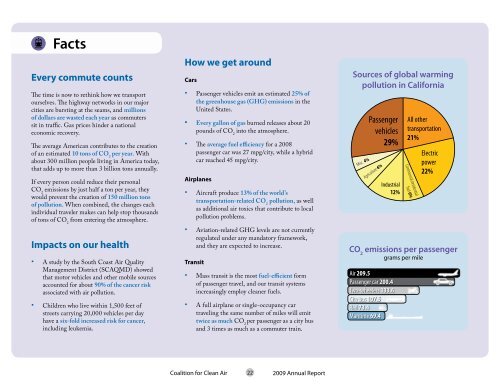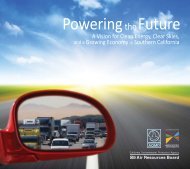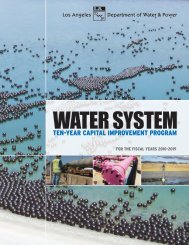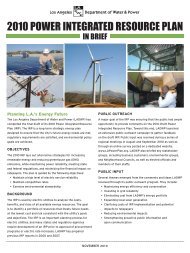The Road To Clean aiR - LA Differentiated
The Road To Clean aiR - LA Differentiated
The Road To Clean aiR - LA Differentiated
You also want an ePaper? Increase the reach of your titles
YUMPU automatically turns print PDFs into web optimized ePapers that Google loves.
j<br />
<br />
N<br />
c ><br />
Facts<br />
Every commute counts<br />
<strong>The</strong> time is now to rethink how we transport<br />
ourselves. <strong>The</strong> highway networks in our major<br />
cities are bursting at the seams, and millions<br />
of dollars are wasted each year as commuters<br />
sit in traffic. Gas prices hinder a national<br />
economic recovery.<br />
<strong>The</strong> average American contributes to the creation<br />
of an estimated 10 tons of CO 2<br />
per year. With<br />
about 300 million people living in America today,<br />
that adds up to more than 3 billion tons annually.<br />
If every person could reduce their personal<br />
CO 2<br />
emissions by just half a ton per year, they<br />
would prevent the creation of 150 million tons<br />
of pollution. When combined, the changes each<br />
individual traveler makes can help stop thousands<br />
of tons of CO 2<br />
from entering the atmosphere.<br />
Impacts on our health<br />
• A study by the South Coast Air Quality<br />
Management District (SCAQMD) showed<br />
that motor vehicles and other mobile sources<br />
accounted for about 90% of the cancer risk<br />
associated with air pollution.<br />
• Children who live within 1,500 feet of<br />
streets carrying 20,000 vehicles per day<br />
have a six-fold increased risk for cancer,<br />
including leukemia.<br />
How we get around<br />
Cars<br />
• Passenger vehicles emit an estimated 25% of<br />
the greenhouse gas (GHG) emissions in the<br />
United States.<br />
• Every gallon of gas burned releases about 20<br />
pounds of CO 2<br />
into the atmosphere.<br />
• <strong>The</strong> average fuel efficiency for a 2008<br />
passenger car was 27 mpg/city, while a hybrid<br />
car reached 45 mpg/city.<br />
Airplanes<br />
• Aircraft produce 13% of the world’s<br />
transportation-related CO 2<br />
pollution, as well<br />
as additional air toxics that contribute to local<br />
pollution problems.<br />
• Aviation-related GHG levels are not currently<br />
regulated under any mandatory framework,<br />
and they are expected to increase.<br />
Transit<br />
• Mass transit is the most fuel-efficient form<br />
of passenger travel, and our transit systems<br />
increasingly employ cleaner fuels.<br />
• A full airplane or single-occupancy car<br />
traveling the same number of miles will emit<br />
twice as much CO 2<br />
per passenger as a city bus<br />
and 3 times as much as a commuter train.<br />
Sources of global warming<br />
pollution in California<br />
Misc. 4%<br />
Passenger<br />
vehicles<br />
29%<br />
Agriculture 6%<br />
Industrial<br />
12%<br />
CO 2<br />
emissions per passenger<br />
grams per mile<br />
Air 209.5<br />
Passenger car 200.4<br />
Two-wheelers 133.6<br />
City bus 107.5<br />
Rail 73.4<br />
Maritime 69.4<br />
Commercial/residential<br />
fuel 6%<br />
All other<br />
transportation<br />
21%<br />
Electric<br />
power<br />
22%<br />
Coalition for <strong>Clean</strong> Air<br />
22<br />
2009 Annual Report





